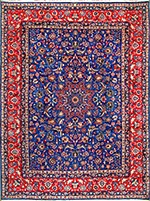Textiles Studies
Date of this Version
1989
Document Type
Article
Citation
Exhibition, The Textile Museum, Washington, DC, October 15, 1989 - February 25, 1990
Abstract
Rugs from the Caucasus have long been appreciated in Europe and America. Widely known for their bright colors and bold designs, Caucasian rugs have attracted collectors for nearly a century. These rugs, produced in towns and villages, reflect regional design traditions which were amalgamated from diverse sources.
Although embroideries and flatweaves (rugs without pile) from the Caucasus are less well known in the West, their designs are no less bold nor their colors less striking. Produced as a domestic art, they were destined for home use and local commerce. The richness of patterns in these textile arts is in part the result of the comings and gOings through the Caucasus of peoples from east and west, north and south. Those who settled in the mountainous regions between the Black Sea and the Caspian Sea migrated there from elsewhere, halted by the barrier of the great mountains. Others were drawn to the region on mercantile business, sometimes leaving in their wake an imprint of their own regional traditions in the arts.
For these reasons, Caucasian rugs, which were primarily woven for commercial purposes and for export, probably represent more distinct and disparate design traditions than rugs from any other rug-producing area of the world.
Three of the most popular deSigns in weavings of the Caucasus are stylized dragons, blossoms, and sunbursts. A fourth variation on a related theme, the medallion, has even wider popularity in Oriental carpets from Turkey and Persia. This exhibition, drawn primarily from The Textile Museum's holdings and complemented by loans from private collections and the Virginia Museum of Fine Arts, presents a rich array of dragons, blossoms, sunbursts, and medallions. Exquisite embroideries are displayed next to flatweaves and carpets, which reflect the same deSigns though executed in different techniques.
The close relationship between structure and design in these textile arts suggests that pile carpets from the Caucasus, woven in the commercial environment of the late 19th and early 20th century, are for the most part derivative, based upon indigenous design traditions that evolved for embroidery, soumak (weft-wrapping), and kilim (slit tapestry) techniques.
Included in
Art and Materials Conservation Commons, Art Practice Commons, Fiber, Textile, and Weaving Arts Commons, Indigenous Studies Commons, Museum Studies Commons


Comments
Copyright © 1989 The Textile Museum